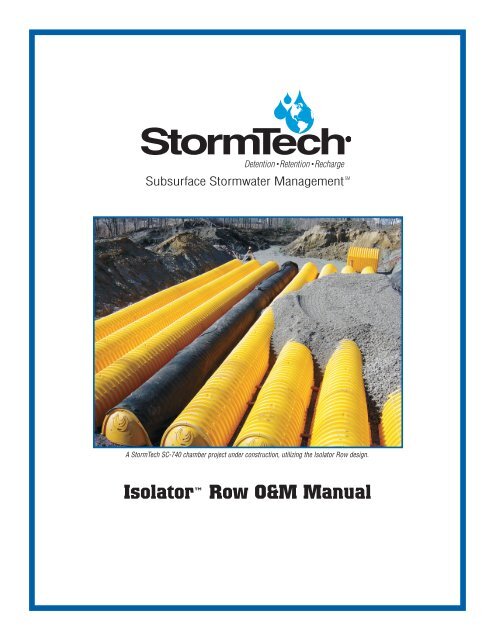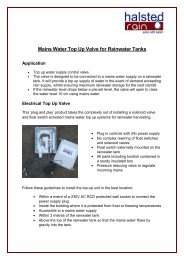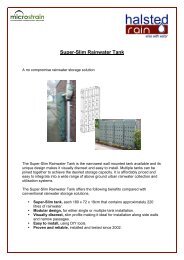Isolator™ Row O&M Manual - Microstrain
Isolator™ Row O&M Manual - Microstrain
Isolator™ Row O&M Manual - Microstrain
Create successful ePaper yourself
Turn your PDF publications into a flip-book with our unique Google optimized e-Paper software.
A StormTech SC-740 chamber project under construction, utilizing the Isolator <strong>Row</strong> design.<br />
Isolator <strong>Row</strong> O&M <strong>Manual</strong>
1.0 The Isolator <strong>Row</strong><br />
1.1 INTRODUCTION<br />
A critical and sometimes overlooked component of any<br />
Stormwater Pollution Prevention Plan is the importance<br />
of inspection and maintenance. Under the proposed EPA<br />
mandated Storm Water Phase II rules, owners and operators<br />
of small municipal separate storm sewer system<br />
(MS4) facilities would be responsible for implementing<br />
BMP inspection and maintenance programs and having<br />
penalties in place to deter infractions (USEPA, 1999).<br />
Looking down the Isolator <strong>Row</strong> from the manhole opening, woven<br />
geotextile is shown between the chamber and stone base.<br />
1.2 THE ISOLATOR ROW<br />
Stormtech has developed a process, the Isolator <strong>Row</strong>,<br />
which has been designed to simplify the inspection and<br />
maintenance procedures while at the same time dramatically<br />
reducing maintenance costs to the end user. The<br />
system can be easily inspected from the surface while<br />
isolating sediments to a relatively small portion of the<br />
bed, reducing cleanout costs.<br />
Typically, the Isolator <strong>Row</strong> is designed to receive the<br />
entire “first flush”. The chambers open bottom, coupled<br />
with engineered perforations in the chambers’ outside<br />
corrugations allow the flow to pass both vertically and<br />
horizontally into the surrounding stone. The stormwater<br />
is thereby evenly distributed throughout the entire<br />
detention/retention system. In large beds, multiple<br />
Isolator <strong>Row</strong>s may be used.<br />
A woven geotextile fabric material is placed between<br />
the bedding stone and the chambers. This serves two<br />
functions, to keep the stone in place when stormwater<br />
enters into the header system at high velocities and<br />
to allow for high pressure cleaning without any<br />
relocation of the stone base.<br />
The Isolator <strong>Row</strong> is configured to enhance the settling<br />
of fine sediment not captured by pre-treatment (i.e.<br />
sumped catch basins, hydrodynamic separators, etc.).<br />
The sediment is then trapped from exiting the perforations<br />
by non-woven geotextile material surrounding<br />
the Isolator <strong>Row</strong> of chambers. This acts to “isolate” the<br />
sediment to one row of chambers, providing a simple<br />
solution to scheduled maintenance, inspection and<br />
long-term performance.<br />
Note: See the most current StormTech Design <strong>Manual</strong><br />
for detailed information on designing inlets for a<br />
StormTech system, including the Isolator <strong>Row</strong>. It is<br />
the ultimate responsibility of the design engineer<br />
to assure that the stomwater system’s design is in full<br />
compliance with all applicable laws and regulations.<br />
StormTech Isolator <strong>Row</strong> with Overflow Spillway<br />
(not to scale)<br />
FROM<br />
PRE-TREATMENT<br />
OVERFLOW SPILLWAY (OPTIONAL)<br />
2 Call StormTech at 888.892.2694 or visit our website at www.stormtech.com for technical and product information.<br />
ISOLATOR ROW
2.0 Isolator <strong>Row</strong> Inspection/Maintenance<br />
2.1 INSPECTION<br />
The frequency of Inspection and Maintenance varies<br />
by location. A routine inspection schedule needs to be<br />
established for each individual location based upon site<br />
specific variables. The type of land use (i.e. industrial,<br />
commercial residential), anticipated pollutant load, percent<br />
imperviousness, climate, etc. all play a critical role<br />
in determining the actual frequency of inspection and<br />
maintenance practices.<br />
At a minimum, StormTech recommends annual inspections.<br />
Initially, the Isolator <strong>Row</strong> should be inspected every<br />
6 months for the first year of operation. For subsequent<br />
years, the inspection should be adjusted based upon<br />
previous observation of sediment deposition.<br />
The Isolator <strong>Row</strong> incorporates a combination of standard<br />
manhole(s) and strategically located inspection ports<br />
(as needed). The inspection ports allow for easy access<br />
to the system from the surface, eliminating the need to<br />
perform a confined space entry for inspection purposes.<br />
If upon visual inspection it is found that sediment has<br />
accumulated, a stadia should be inserted to determine<br />
the depth of sediment. When the average depth of<br />
sediment exceeds 3 inches throughout the length of<br />
the Isolator <strong>Row</strong>, clean-out should be performed.<br />
2.2 MAINTENANCE<br />
The Isolator <strong>Row</strong> was designed to reduce the cost of<br />
periodic maintenance. By “isolating” sediments to just<br />
one row, costs are dramatically reduced by eliminating<br />
the need to clean out each row of the entire storage<br />
bed. If inspection indicates the potential need for maintenance,<br />
access is provided via a manhole(s) located<br />
on the end(s) of the row for cleanout. If entry into the<br />
manhole is required, please follow local and OSHA rules<br />
for a confined space entries.<br />
StormTech Isolator <strong>Row</strong> (not to scale)<br />
CATCH BASIN<br />
OR MANHOLE<br />
2 FT MIN. SUMP<br />
SC-740 12"-25" MAX. O.D. PIPE<br />
SC-310 8"-12" PIPE<br />
SET NEAR BOTTOM OF CHAMBER<br />
INSPECTION PORT<br />
BY DESIGN<br />
WOVEN GEOTEXTILE BETWEEN STONE BASE AND CHAMBERS<br />
THAT MEETS AASHTO M288 CLASS 1 REQUIREMENTS<br />
SC-740 – 5'-6' WIDE STRIP<br />
SC-310 – 4' WIDE STRIP<br />
Examples of culvert cleaning nozzles appropriate for Isolator <strong>Row</strong><br />
maintenance. (These are not StormTech products.)<br />
Maintenance is accomplished with the JetVac process.<br />
The JetVac process utilizes a high pressure water nozzle<br />
to propel itself down the Isolator <strong>Row</strong> while scouring<br />
and suspending sediments. As the nozzle is retrieved,<br />
the captured pollutants are flushed back into the manhole<br />
for vacuuming. Most sewer and pipe maintenance<br />
companies have vacuum/JetVac combination vehicles.<br />
Selection of an appropriate JetVac nozzle will improve<br />
maintenance efficiency. Fixed nozzles designed for culverts<br />
or large diameter pipe cleaning are preferable.<br />
Rear facing jets with an effective spread of at least 45”<br />
are best. Most JetVac reels have 400 feet of hose allowing<br />
maintenance of an Isolator <strong>Row</strong> up to 50 chambers<br />
long. The JetVac process shall only be performed on<br />
StormTech Isolator <strong>Row</strong>s that have AASHTO class 1<br />
woven geotextile (as specified by StormTech) over<br />
their angular base stone.<br />
COVER ENTIRE ROW WITH AASHTO M288<br />
CLASS 2 NON-WOVEN GEOTEXTILE<br />
SC-740 – 8' WIDE STRIP<br />
SC-310 – 5' WIDE STRIP<br />
STORMTECH ENDCAP<br />
Call StormTech at 888.892.2694 or visit our website at www.stormtech.com for technical and product information. 3
3.0 Isolator <strong>Row</strong> Step By Step Maintenance Procedures<br />
STORMTECH ISOLATOR ROW<br />
Step 1) Inspect Isolator <strong>Row</strong> for sediment<br />
A) Inspection ports (if present)<br />
i. Remove lid from floor box frame<br />
ii. Remove cap from inspection riser<br />
iii. Using a flashlight and stadia, gage depth of sediment<br />
iv. If sediment is at or above 3 inch depth proceed to Step 2. If not proceed to step 3.<br />
B) All Isolator <strong>Row</strong>s<br />
i. Remove cover from manhole at upstream end of Isolator <strong>Row</strong><br />
ii. Using a flashlight, inspect down Isolator <strong>Row</strong> through outlet pipe<br />
1. Mirrors on poles or cameras may be used to avoid a confined space entry<br />
2. Follow OSHA regulations for confined space entry if entering manhole<br />
iii. If sediment is at or above the lower row of sidewall holes (approximately 3 inches) proceed to Step 2.<br />
If not proceed to Step 3.<br />
Step 2) Clean out Isolator <strong>Row</strong> using the JetVac process<br />
A) A fixed culvert cleaning nozzle with rear facing nozzle spread of 45 inches or more is preferable<br />
B) Apply multiple passes of JetVac until backflush water is clean<br />
C) Vacuum Manhole sump as required<br />
Step 3) Replace all caps, lids and covers<br />
Step 4) Inspect & clean catch basins and manholes upstream of the StormTech system<br />
StormTech Isolator <strong>Row</strong> (not to scale)<br />
4<br />
1) B) iii<br />
2<br />
StormTech products are covered by one or more of the following patents: U.S. Patents: 5,401,459; 5,511,903; 5,716,163; 5,588,778; 5,839,844;<br />
Canadian Patents: 2,158,418 Other U.S. and Foreign Patents PendingPrinted in U.S.A.<br />
© Copyright. All rights reserved. StormTech Inc., 2003 S090603AG-0<br />
1) A) iii<br />
P.O. Box 619 Old Saybrook Connecticut 06475<br />
860.577.7015 888.892.2694 fax 860.577.7016 www.stormtech.com





